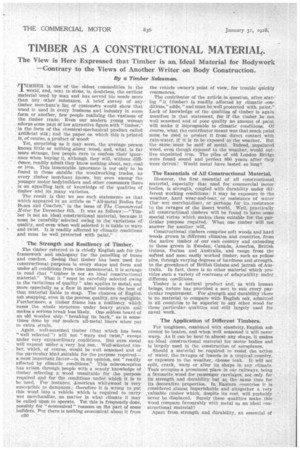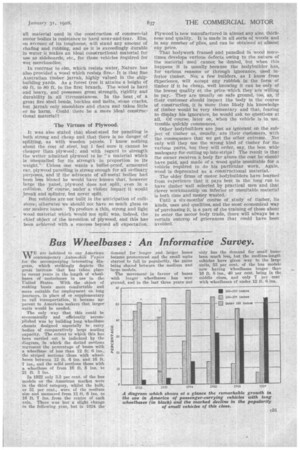TIMBER AS A CONSTRUCTIONAL MATERIAL.
Page 52

Page 53

If you've noticed an error in this article please click here to report it so we can fix it.
The View is Here Expressed that Timber is an Ideal Material for Bodywork —Contrary to the Views of Another Writer on Body Construction.
• By a Timber Salesman.
TIMBER in one of the oldest commodities in the world, and, next to stone, is, doubtless, the earliest material used by man and has served his needs more than any other substance. A brief survey of any/ timber merchant's list of customers would show that wood is used in every business and industry in some form or another, few people realizing the vastness of the timber trade. Even our modern young woman adorns some part of her attractive figure with "timber," in the form of the chemical-mechanical product called artificial ailk ; and the paper on which this is printed is, of course, a product of wood`
Yet, surprising as it may seem, the average person knows little or nothing -about wood, and, what is far more strange, few people care to confess their ignorance when buying it, although they will, without diffidence, readily admit they know nothing about, say, coal or iron. This lamentable ignorance is not only to be found in those outside the woodworking trades, as every timber merchant knows, but even among the younger motor bodybuilders and other consumers there is an appalling lack of knowledge of the qualities of timber and its many varieties.
The result iS that we see such statements as thatwhich appeared in an article on "All-metal Bodies for Buses and Coaches," in the issue of The Commercial Motor for December 6th. It was as follows :—"Timher is not an ideal constructional material, because it must be carefully selected owing to the variations of quality, and even when well selected it is liable to warp and twist. It is readily affected by climatic conditions and must be well protected with paint."
The Strength and Resiliency of Timber.
The timber referred to is chiefly English ash for the framework and mahogany for the panelling of buses and coaches. Seeing that timber has been used for constructional purposes in every shape and form and under all conditions from time immemorial, it is strange to read that "timber is not an ideal constructional material." That it "must be carefully selected owing to the variations of quality" also applies to metal, and more eftspecially as a flaw in metal renders the best of that material liable to snap. The chances of English ash snapping, even in the poorest quality, are negligible. Furthermore, a timber frame has a resiliency which 'eases , the whole structure under heavy strain and makes a serious break less likely. One seldom heard of an old wooden ship "breaking its baek," as is sometimes done by our modern all-metal liners when nut to extra strain.
Again, well-seasoned timber (that which has been "well Selected ") will not "warp and twist," except under very extraordinary ,conditions. But even metal will expand under a very hot sun. Well-selected timber, which, of course, would be well seasoned and of the particular kind suitable for the purpose required— a most important factor—is, in my opinion, not "readily affected by climatic conditions." This misconception has arisen through people with a scanty knowledge of timber selecting a wood unsuitable for the purpose required and for the conditions under which it is to be. used. For instance, American whitewood is very susceptible to dampness ; therefore it is wrong to put this wood into a vehicle which is required to carry wet merchandise, no matter in what climate it may be called upon to operate. Yet this is frequently done, possibly for "economical" reasons on the part of some builders. Pet there is nothing economical about it from the vehicle owner's point of view, for trouble quickly commences.
The contributor of the article in question, after stab'' log "it (timber) is readily affected by climatic conditions," adds, "and must be well protected with paint." Lack of knowledge of the qualities of timber is again manifest in that statement, for if the timber be not well seasoned and of poor quality no amount of paint will make it impregnable to climatic conditions. Of course, what the contributor meant was that much paint must he used, to protect it from direct contact with rain-water, if it is to be exposed to the weather. But the same must be said of metal. Indeed, unpainted wood, even though exposed to the weather, would outlive unpainted iron. The piles of okl London Bridge were found sound and perfect 800 years after they were driven! Would metal have lasted so long?
The Essentials of All Constructional Material.
However, the first essential of all constructional material, especially that used for commercial motor bodies, is strength, coupled with durability under different working conditions: it may be, exposure to the weather, hard wear-and-tear, or resistance of water (for wet merchandise), or perhaps for ita resistance to the ravages of the insect world. Well, • practically all constructional timbers will be foung to have some special virtue which makes them suitable for the particular purpose required. What one timber will not answer for another win.
Constructional timbers comprise soft woods and hard woods grown in different climates and countries, from the native timber of our own country and extending to those grown in Sweden, Canada, America., British Guiana, Burma and Australia, and range from the softest and mosi: easily worked timber, such as yellow pine, through varying degrees of hardness and strength, to the greenheart of British Guiana and jarrah of Australia. In fact, there is no other material which provides such a variety of contrasts of adaptability under different conditions.
Timber is a natural product and, as with human beings, nature has provided a sort to suit every particular requirement. For strength and durability there' is no material to compare with English oak, admitted in all countries to be superior to any other wood for these . particularqualities and still largely used for naval work.
The Application of Different Timbers.
For toughness, combined with elasticity, English ash cannot be beaten, and when well seasoned it will never warp. As it can be bent to almost any shape, it makes an ideal constructional material for motor bodies and is largely used in the construction of aeroplanes.
Should a material be required to resist the action of water, the ravages of insects in a tropical country. or exposure to the weather, choose teak. It will not split, crack, warp or alter its shape in any climate. Teak occupies a prominent place in our railways, being a favourite wood for passenger carriages, not only for its strength and durability but at the same time for its decorative properties. In Eastern countries it is considered almost imperishable and altogether a very , valuable timber which, despite its cost, will probably never be displaced. Surely these qualities make this wood compare favourably with metal as an ideal constructional material?
Apart from strength and durability, an essential of all material used in the construction of commercial motor bodies is resistance to hard wear-and-tear. Elm, on account of its toughness, will stand any amount of chafing and rubbing, and as it is exceedingly durable in water it makes an ideal constructional material for use as sideboards, etc., for those vehicles required for wet merchandise.
In contrast to elm, which resists water, Nature has also provided a wood which resists fire.It is that fine Australian timber jarrah, highly valued in the shipbuilding yards. As a forest tree it attains a height of 60 ft. to 80 ft. to the first branch. The wood is hard and heavy, and possesses great strength, rigidity and durability in , all -eircumstances. In the heat of a. great fire steel bends, buckles and melts, 'stone cracks, but jarrah only smoulders and chars and takes little or no harm. Could there be a more ideal constructional material?
The Virtues of PlyWood.
It was also stated that sheet-steel for panelling is both strong and cheap and that there is no danger of splitting, as with wooden panels. I know nothing about the cost of steel, but I feel sure it cannot be cheaper than plywood; and with regard to strength the writer admitted plywood to be "a material which is unequalled for its strength in proportion to its weight." Unless one wants a bullet-proof, armoured ear, plywood panelling is strong enough for all ordinary purpeses, and if the advocate of all-metal bodies had been less biased he would have known that, however large the panel, plywood does •not split, even in a collision. Of course, under 11 violent impact it would break and splinter, but never split.
But vehicles' are not built in the anticipation of collisions; otherwise We should not have so much glass on our modern buses. To produce a thin, strong and light wood material which would not split was, indeed; the Chief object of the invention of plywood, and this has been achieved with a success beyond all expectation. Plywood is now manufactured in almost any size, thickness and quality. It is made in all sorts of woods and in any number of plies, and can be obtained at almost any price.
That bodywork framed and panelled in wood sometimes develops various defects owing to the nature of the material used cannot be denied, but when this happens it is usually because the bodybuilder has, for various reasons or through ignorance, used inferior timber. Not a few builders, as I know from experience, will accept any rubbish in the form of timber if it be cheap, well knowing it can be only of the lowest quality at the price whichthey are willing to pay. They are usually on safe ground, too, as, if their customer should inspect the body in the course of construction, it is more than likely his knowledge of timber would be very elementary and that, fearing to display his ignorance, he would ask no questions at all. Of course, later on, when the vehicle is in use, trouble quickly commences.
Other bodybuilders are just as ignorant on the subject of timber as, usually, are their Customers, with the consequence that we get the other extreme. Not only will they use the wrong kind of timber for the various parts, but they will order, say, the best wide mahogany for cutting up into strips The result is that the owner receives a body far above the cost he should have paid, and made of a wood quite unsuitable for a vehicle required to do his particular work. Again, wood is deprecated as a constructional material.
The older firms of motor bodybuilders have learned from experience that it pays best in the long run to have timber well selected by practical men and that clever workmanship on inferior or unsuitable material is both time anti money wasted.
Until a six-months' course of study of timber, its kinds, uses and qualities, and the most economical way of purchasing it, is a part of the training of those about to enter the motor body trade, there will always be a certain outcrop of grievances that could have been avoided.












































































































